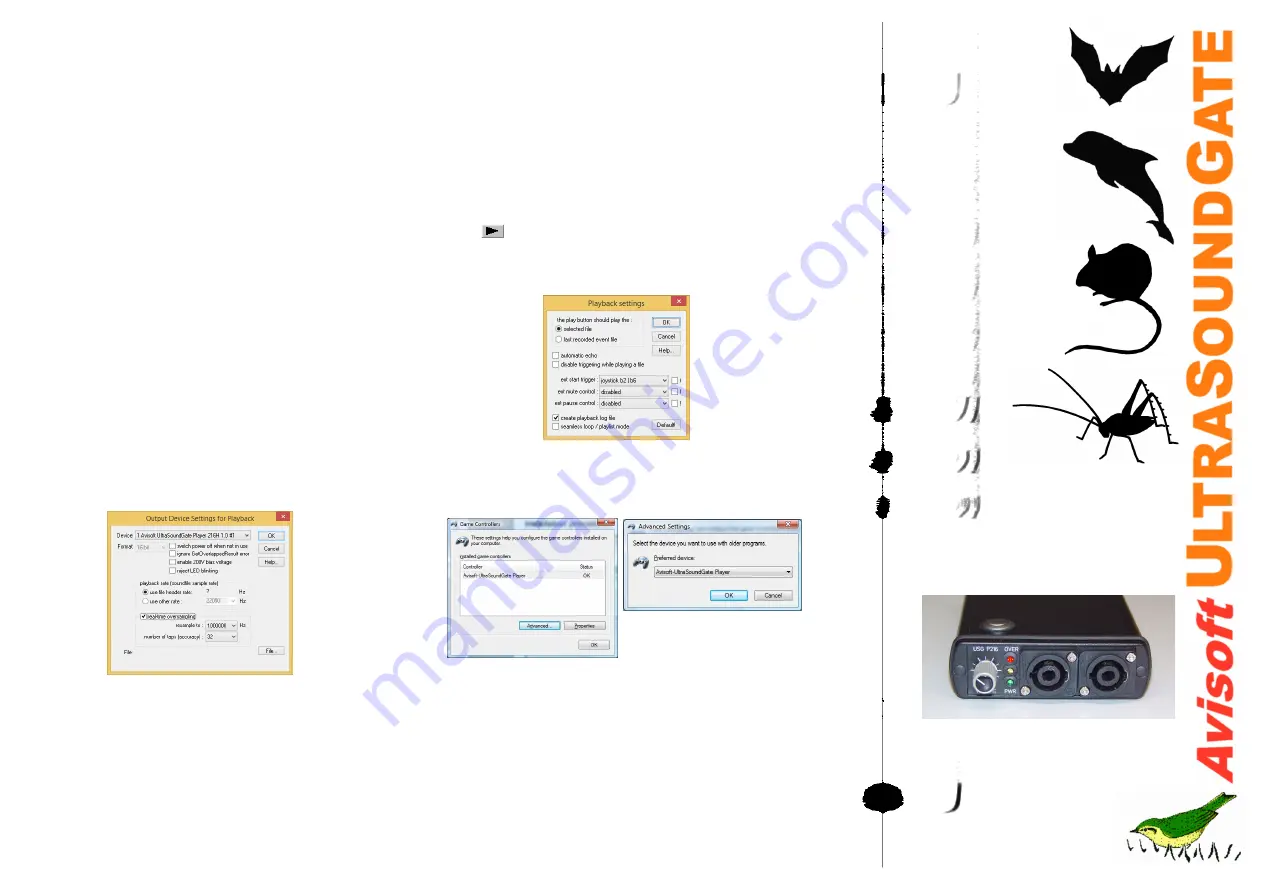
There are several ways to play a .wav file:
a) Select the desired file from the command
Play / File..
.
b) Locate the desired file on a Windows folder and drag it into the
RECORDER USGH window.
c) Prepare a list of files from the command
Play / Playlist..
. and
play the selected files according to the settings made there.
Once a .wav file has been selected (according to the above option
a or b), this file can be played several times either by executing the
command Play/Start (Shift+Space bar), by clicking at the Play
button or by pressing the physical trigger button on the
device.
The latter option requires that the “joystick b2|b6” option has been
selected as the “ext start trigger” from the command
Play/Settings...
Getting started
User's Guide
After installing the Avisoft-RECORDER USGH Software and
connecting the UltraSoundGate Player to the computer, the
RECORDER USGH software can be launched from the Windows
Start menu
All
Programs / Avisoft Bioacoustics / RECORDER
USGH
.
The playback functionality of the RECORDER software is located
on the
Play
menu.
First go to the command
Play
/
Device
... and select the Avisoft
UltraSoundGate Player 216H from the
Device
listbox at the top of
the dialog box.
Normally, the
playback rate
option “use the file header rate”
should be selected. In this case, the playback sample rate will be
taken from the file header of the .wav file, which will ensure that the
file is being played at the correct speed. Note that the USG Player
216H hardware only supports a sample rate of 1000 kHz. If the
original .wav file to be played has a different sample rate, it is
necessary to resample it to 1 MHz. This can be done for instance
in Avisoft-SASLab Pro from the command
“Edit”/”Format”/”Sampling Frequency Conversion...”
Alternatively, the sample rate can be converted by the RECORDER
USGH software in real-time. This mode of operation can be
activated by checking the option
real-time opversampling
. The
list box titled
number of taps (accuracy)
will determine the
accuracy of the conversion. Higher values will increase the
accuracy but will also increase the CPU usage. Slower PC's may
be unable to process the data in real-time (which can be
recognized by a distorted playback and the inability of the
RECORDER software to respond to user inputs during the
playback). Under these circumstances, it is therefore
recommended to resample the sound files in advance by in Avisoft-
SASLab Pro.
In the bus-powered operation mode, the option “
switch power off
when not in use
” will reduce the current drawn from the USB while
no file is being played (the power amplifier will be switched off
between playbacks). However, switching on and off the amplifier at
the begin and end of each file can create an undesired noise. If this
noise is unacceptable, the option should be disabled.
The option
enable 200V bias voltage
should be activated when
electrostatic speakers are being used.
The option
reject LED blinking
will switch off the amber-colored
Play LED during standby mode when no file is being played
(otherwise the LED is blinking to indicate the USB connection).
When simultaneously playing via the USG Player and recording via
an UltraSoundGate xx16 at the same time, it is necessary to
launch a separate instance of the RECORDER USGH software for
the playback task. Otherwise, the recording and playback
procedures might disturb each other (gaps might occur in the data
streams).
Additionally, it might be necessary to activate the USG Player
game controller from the Windows Control Panel (Hardware and
Sound > Game Controllers) in order to get it work with the
RECORDER USGH software:
USG Player 216H
Playing .wav files
In order to play two independent signals through the two channels of
the unit, a 2-channel (stereo) .wav file must be prepared. This could
be done for instance in Avisoft-SASLab Lite / Pro with the command
File/Specials/Add channel(s) from file...
Use the command
File/Specials/Swap channels
to interchange the two channels if
necessary. Single-channel .wav files will be reproduced through
both channels.




